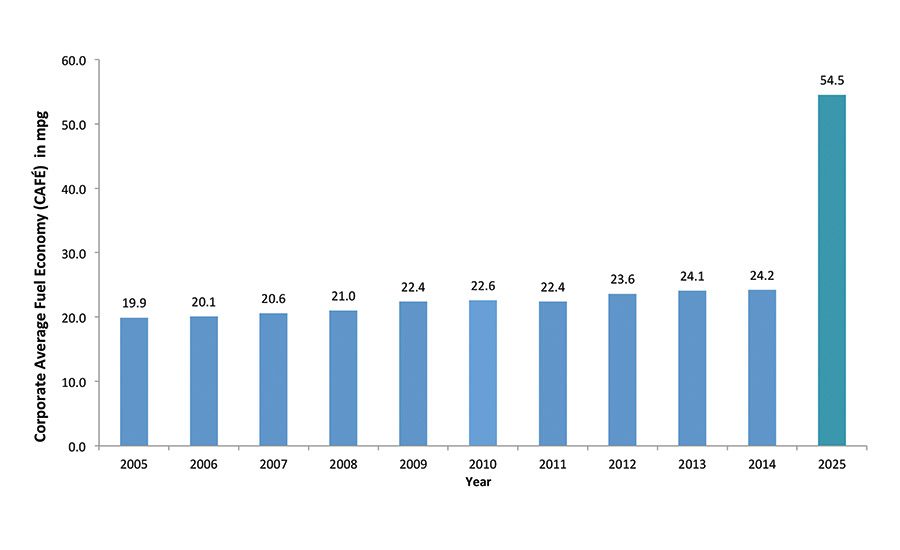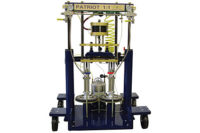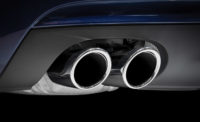Market Trends: Lightening Up with Carbon Fiber-Reinforced Plastics
The market for carbon fiber-reinforced plastics composites is projected to grow 9.9% between 2015 and 2020, mainly due to demand in the aerospace and defense and automotive sectors.






Carbon fiber-reinforced plastics (CFRP) are lightweight and high-strength composites designed for enhanced performance in a number of applications. They offer improvement in structural, functional or cosmetic properties. The market size for CFRP composites accounted for $20.3 billion in 2014, and is projected to register a compound annual growth rate (CAGR) of 9.9% between 2015 and 2020, to reach $35.8 billion.
Carbon fiber composites are traditionally used in the aerospace and defense industry, due to physical and mechanical properties such as light weight, high mechanical strength, thermal and chemical stability, recyclability dimensional stability, and heat resistance. Today, carbon fiber composites are finding new uses in wind turbine, sporting goods, automotive, marine, construction and other applications. The demand growth of carbon fiber composites in these applications is driven by their lightweight properties, fuel economy benefits and other performance features.
Carbon fiber composites’ light weight and high strength allow them to penetrate the aerospace and defense application by replacing metal. The aerospace and defense segment is estimated to have dominated the carbon fiber composites market in 2014. Automotive is the most promising application for carbon fiber composites, and offers the highest growth potential. Many leading automotive manufacturers, such as BMW and Mercedes, are planning to scale up their production of fuel efficient cars through weight reduction by using carbon fiber. These efforts are projected to drive the carbon fiber composites market in the automotive industry, making it the leading industry by 2020.
Aerospace and Defense
Carbon fiber and carbon fiber composites are used widely in aircraft components and structures, as their superior strength-to-weight ratio significantly exceeds that of any metal. Airbus superjumbo commercial aircraft A380 and A350 and Boeing’s B-787 are built with carbon fiber and carbon fiber composites. In addition, in the production of helicopters, gliders, fighter jets, and microlights, carbon fiber composites are helping to increase range and simplify maintenance.
Figure 1 shows the major aircrafts and carbon fiber consumption per unit of the aircraft, indicating a sharp increase in the use of carbon fiber composites in Boing’s and Airbus aircrafts. The widespread use of composites in the Dreamliner (B787) reduces fuel consumption by 20%, compared to any other aircraft of its size.
Carbon fiber composites are used in different components of aircrafts, such as floor beams, ailerons, vertical stabilizers, elevators and engine nacelles. The use of carbon fiber composites has increased in other segments such as general aviation aircraft, helicopter, and alternative structures including airframes, fuselage, and rotor blades. Carbon fiber composites have been used for the F-22A Raptor fuselage frame, which has more than 350 carbon composite parts. In addition, nearly one-third of the joint strike fighter plane is made of carbon fiber composites. Apart from this, carbon fiber composites are also used for Blackhawk helicopters, body armor, helmets, holsters, space shuttles, and many other military applications such as radoms, rocket motor casing, fairings, satellites, antenna dishes, and missiles.
Currently, Boeing 787’s fuselage is made of carbon fiber, which reduces its weight by 20%. In addition, carbon fiber is also used in wing components such as vertical stabilizers, flaps, aileron, and other parts of the aircraft. In tail components, carbon fiber is used in tail cone and tail flaps. B787 production is expected to increase from 10 units per month to 12 units per month by 2016. Airbus A350 has reportedly already received a great response from different airlines, with Qatar airways and Delta ordering 80 and 25 airplanes, respectively. Lufthansa has also ordered 25 A350 aircraft, which are expected to be delivered in 2017.
Wind
The use of carbon fiber and carbon fiber composites in wind blades significantly reduces the weight of the turbine blade by increasing its length for more electricity generation. Lighter blades require less robust turbine and tower components, thus the cost savings justify the additional cost of carbon. The leading wind turbine manufacturers, such as Vestas Wind Systems A/S (Denmark) and Gamesa Technology Corp. (Spain), have already proven the carbon fiber technology in the wind energy market. Wind turbine blade manufacturing has been growing in the last decade, and production is expected to grow at a significant rate in the next decade. GE Energy has started using carbon fiber in its next-generation wind blades.
Carbon fiber composites offer stiffness and high strength-to-weight ratio, which are the key drivers for the carbon fiber composites industry to expand in the wind energy market. Carbon fiber is typically used in the spar caps of large wind blades and optimizes the stiffness-to-weight ratio in longer blades. Carbon fiber composites have also added the benefits of reducing the thickness of fiberglass laminate sections to resolve problems associated with resin wetting of thick lay-up sections.
Globally, around 51 GW new installations were added in 2014, driving the carbon fiber composites market. The U.S. government renewed the Production Tax Credit (PTC) in 2014 to provide financial assistance to wind energy producers. Moreover, PTC also assists wind energy developers in securing private financing for wind installation projects. As the world’s largest wind energy producer, China is still showing strong growth prospects due to government support and ambitious renewable energy targets.
Automotive
The complexities of carbon fiber composites pose some challenges for original equipment manufacturers (OEMs), but recent success in growing composites expertise among universities, governments, and increasingly able suppliers can assist automakers to select the ideal material for their application. Carbon fiber composites are primarily used in the automotive segment to reduce vehicle weight, thus increasing in fuel efficiency. The most common automotive components where carbon fiber and carbon fiber composites are used include exterior body parts, hoods, bonnets, and test plates.
To make vehicles lighter, safer, cleaner and more cost-effective, the leading carbon fiber composites suppliers are responding to the needs and expectations of the vehicle OEMs, system suppliers, and customers. Many car companies, such as BMW, Audi and GM, have established agreements with carbon fiber composite material producers for mass production, and are investing in their processes to support low-cost carbon fiber composites manufacturing.
More recently, BMW used carbon fiber in its “i” series and achieved success to reduce the 250-350 kilos (550-770 lbs) weight of the car and increased the fuel efficiency. The demand for these cars is projected to continue increasing in the near future; the joint venture between BMW and SGL is estimated help support this demand by supplying carbon fiber. This encourages other car manufacturers to develop their technology around carbon fiber. In line with this, Apple is planning to adopt BMW i3’s carbon fiber body for its future electric car. Moreover, the average costs of lightweight carbon fiber parts today is $120-130/kg; 25-30% of this estimate accounts for materials, with the remainder (70-75%) for manufacturing. Many leading research institutes, CF manufacturers, and OEMs are working to reduce the cycle time and raw material costs for mass production of lightweight vehicles.
The key manufacturers of carbon fiber composites are helping automotive manufacturers in the U.S. to meet the strict environmental standards set by the Obama administration, requiring lightweight vehicles to achieve a corporate average fuel efficiency (CAFE) standard of 36.6 mpg by 2017 and 54.5 mpg by 2025. Reductions in weight, fuel economy and other performance benefits of carbon fiber are projected to drive the carbon fiber composites market in the coming years. Europe and other regions are also showing significant interest in carbon fiber composite applications in the automotive industry.
Sporting Goods Industry
Carbon fiber composite characteristics like high tensile modulus, low density and light weight make them suitable for many sporting goods applications, such as tennis rackets, golf shafts, fishing poles, skis, snowboards, softball bats, hockey sticks, and bicycle frames. Currently, carbon fiber is also used in sports footwear. Custom carbon fiber cycling shoes are shaped and baked for the users, while carbon fiber strips are used to stiffen the sole.
In sporting goods, small tow carbon fibers (3K, 12K) with standard and higher performance grades are normally used in prepreg form. Among the sporting goods, composite golf shafts account for the largest market share and have been the main driver for the industry. Tennis, racquetball, squash and badminton racquets collectively account for the second-largest sporting category for carbon fiber composites’ consumption. Due to these properties, the use of carbon fiber composites in sporting goods is expected to register a strong CAGR of 8.5% by volume between 2015 and 2020.
Construction
Carbon fiber composites are widely used in several structural engineering applications due to their light weight, high strength, good durability and stiffness. In the construction industry, carbon fiber composites are used for the development and reinforcement of structures that are in the form of cloth and sheets on surfaces of beam, floors, roofs, and bridges. For instance, concrete reinforced with carbon fiber is used in retrofitting to increase the load capacity of bridges and other old structures.
Worldwide, the U.S. represents the major construction market for carbon fiber composites. Although the cost of carbon fiber is high, due to its competence to stabilize structures and buildings over the long term, the construction sector creates giant opportunities for the growth of the carbon fiber market. In addition, mainly in Japan, carbon fiber is extensively used to strengthen buildings against natural disasters such as earthquakes.
Marine
Use of carbon fiber and carbon fiber composites in the marine industry reduces the overall weight of the ships, thus easing their transport and installation while reducing wear on bearings and shafts during operation. The increased use of carbon fiber in cruiser boats is driving the carbon fiber composites market growth in the marine industry. With the increasing use of carbon fiber in the marine industry, applications such as yachts, cruisers, and racing vessels are projected to be lighter and stronger, as carbon composite material can sustain extreme environment conditions. Hence, the carbon fiber composites market in the marine segment is expected to register a CAGR of 8.6% by volume from 2015 to 2020.
Reducing Costs is Key
Several factors are driving the market, but the cost of carbon fiber is a major barrier in the growth of the carbon fiber composites market. The average cost of raw carbon fiber is estimated at around $20/kg, compared to less than $1/kg for steel. Research centers, carbon fiber manufacturers, and end-use industries are taking efforts to reduce the cost of carbon fibers for use in different applications. Also, the mass production of electric cars is now possible due to the increased use of carbon fiber.
MAI Carbon Cluster Management, a research effort supported by the German government, and a group of companies that includes BMW, Audi, Airbus, and Siemens, aims to reduce the cost of carbon fibers and parts made of carbon fibers through reducing the cycle time. Such efforts definitely help to reduce the cost of carbon fiber production at a remarkable extent through reducing the cycle time. Many other companies are also undertaking new partnerships and joint ventures: GM’s alliance with Japan-based Teijin to develop a high-throughput “part-per-minute” production process for carbon fiber car parts; Ford’s partnership with Dow Chemical; Japanese company Toray’s R&D efforts with Toyota, Daimler, and Honda; Volkswagen’s and BMW’s investments in SGL (Germany); and joint research by Zoltek and Weyerhaeuser to develop lignin-based fiber precursors. All these efforts in the industry are expected to reduce the overall cost of carbon fibers and parts made from them in the near future.
For more information, phone (888) 600-6441, email sales@marketsandmarkets.com or visit www.marketsandmarkets.com.
Author’s note
Any work, report, notes, article, presentation, graphics, photographs, analysis, forecast submitted by Markets and Markets as part of ‘this submission’ shall not amount to any form of assurance or guarantee that Markets and Markets have determined or predicted future events or circumstances. Markets and Markets disclaims any responsibility, liability to any party for any losses, costs, damages, liabilities, expenses incurred directly or indirectly by anyone as a result of use, reproduction, circulation, publication, or use of this submission in whole or in part.
Looking for a reprint of this article?
From high-res PDFs to custom plaques, order your copy today!








